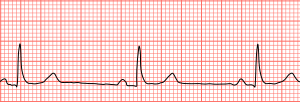Sinus bradycardia
Sinus bradycardia is a sinus rhythm with a rate that is lower than normal. In humans, bradycardia is generally defined to be a rate of under 60 beats per minute.
| Sinus bradycardia | |
|---|---|
 | |
| Sinus bradycardia seen in lead II with a heart rate of about 50. | |
| Specialty | Cardiology |
Signs and symptoms
The decreased heart rate can cause a decreased cardiac output resulting in symptoms such as lightheadedness, dizziness, hypotension, vertigo, and syncope. The slow heart rate may also lead to atrial, junctional, or ventricular ectopic rhythms.
Bradycardia is not necessarily problematic. People who regularly practice sports may have sinus bradycardia, because their trained hearts can pump enough blood in each contraction to allow a low resting heart rate. Sinus bradycardia can also be an adaptive advantage; for example, diving seals may have a heart rate as low as 12 beats per minute, helping them to conserve oxygen during long dives.[1]
Sinus bradycardia is a common condition found in both healthy individuals and those who are considered well conditioned athletes.
Heart rates considered bradycardic vary by species; for example, in the common housecat, a rate of under 120 beats per minute is abnormal. Generally, smaller species have higher heart rates while larger species have lower rates.
Causes
- This rhythm may be caused by:
- Acute myocardial infarction
- Drugs, such as: digitalis, beta-blockers, quinidine, adenosine, or calcium channel blockers.
- Carotid sinus syndrome.
- Eating disorders, such as anorexia nervosa.
- Rhodotoxin poisoning.
- Hypothermia
- Hypothyroidism
- Increased vagal tone.
- Increased intracranial pressure.
- Infections like diphtheria, acute rheumatic fever, or viral myocarditis.
- Intrinsic disease of the SA node (E.g. sick sinus syndrome).
- Normal finding in a healthy, well-conditioned person.
- Roemheld syndrome
- Seizure.
- Sleep
Diagnosis
ECG characteristics
- Rate: Less than 60 beats per minute.
- Rhythm: Regular.
- P waves: Upright, consistent, and normal in morphology and duration.
- PR interval: Between 0.12 and 0.20 seconds in duration.
- QRS complex: Less than 0.12 seconds in width, and consistent in morphology.
See also
References
- THORNTON (2004). "Oxygen and the diving seal" (PDF). The Journal of Hyperbaric Medicine. 31 (1): 81–95. Retrieved 29 July 2014.